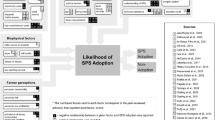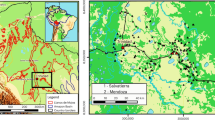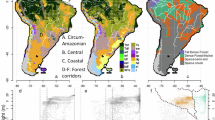Abstract
Current social-technical and political conditions threaten the integrity of the Amazon biome. Overcoming these lock-ins requires structural transformations away from conventional economies towards ‘socio-bioeconomies’ (SBEs). SBEs are economies based on the sustainable use and restoration of Amazonian ecosystems, as well as Indigenous and rural livelihood systems in the region. They include sustainable eco-tourism as well as diversified production and innovative processing of fruits, nuts, oils, medicines, fish and other products deriving from socio-biodiversity. Using a sustainability transitions perspective, we argue for multi-scalar policy changes to sustain, enhance and scale-out and scale-up SBE initiatives. To nurture niche SBE acitivities, we advocate for improvements in infrastructure, value chains and social organizations. To dismantle structural barriers, we call for an end to harmful subsidies, greater representation of marginalized communities in territorial planning, enhanced rural–urban and intersectoral linkages, international collaboration, shifts in demand, and changes in conservation and production narratives. Policies for SBEs must also use clear definitions, participatory processes and a multi-biome approach to avoid perverse outcomes.
This is a preview of subscription content, access via your institution
Access options
Access Nature and 54 other Nature Portfolio journals
Get Nature+, our best-value online-access subscription
$32.99 / 30 days
cancel any time
Subscribe to this journal
Receive 12 digital issues and online access to articles
$119.00 per year
only $9.92 per issue
Buy this article
- Purchase on SpringerLink
- Instant access to full article PDF
Prices may be subject to local taxes which are calculated during checkout


Similar content being viewed by others
References
Flach, R. et al. Conserving the Cerrado and Amazon biomes of Brazil protects the soy economy from damaging warming. World Dev. 146, 105582 (2021).
Hecht, S. B. Soybeans, development and conservation on the Amazon frontier. Dev. Change 36, 375–404 (2005).
Celentano, D., Sills, E., Sales, M. & Veríssimo, A. Welfare outcomes and the advance of the deforestation frontier in the Brazilian Amazon. World Dev. 40, 850–864 (2012).
Rodrigues, T. Agricultural explosion in Brazil: exploring the impacts of the Brazilian agricultural development over the Amazon. Int J. Sociol. Agric Food 16, 1–12 (2009).
SPA Sustainable Infrastructure Policy Brief (SPA, 2023).
Smits, J. & Permanyer, I. The Subnational Human Development Database. Sci. Data 6, 190038 (2019).
Vera V, R. R., Cota-Sánchez, J. H. & Grijalva Olmedo, J. E. Biodiversity, dynamics, and impact of chakras on the Ecuadorian Amazon. J. Plant Ecol. 12, 34–44 (2017).
Torres, B., Maza, O. J., Aguirre, P., Hinojosa, L. & Günter, S. in Handbook of Climate Change Adaptation (ed. Leal Filho, W.) 1973–1994 (Springer, 2015).
Torres, B. et al. Estudios Sobre Medios de Vida, Sostenibilidad y Captura de Carbono en Chakra con Cacao: Casos de las Asociaciones Kallari, Wiñak y Tsatsayaku, Amazonía Ecuatoriana (FAO–Ecuador, 2022).
Abramovay, R. et al. In Amazon Assessment Report 2021 (eds Nobre, C. et al.) Ch. 30 (United Nations Sustainable Development Solutions, 2021).
Hecht, S. et al. In Amazon Assessment Report 2021 (eds Nobre, C. et al.) Ch. 14 (United Nations Sustainable Development Solutions, 2021).
Schlemer Alcantara, L. C. & Cioce Sampaio, C. A. Bem viver como paradigma de desenvolvimento: utopia ou alternativa possível? Desenvolv. Meio Ambiente https://doi.org/10.5380/dma.v40i0.48566 (2017).
Leon, L. P. Brazil unveils ecological plan at COP28 as Global South proposal. Agência Brasil (12 January 2023).
Ministério do Desenvolvimento e Assistência Social, Família e Combate à Fome. MDS, MMA e MDA se unem para elaborar Plano Nacional da Sociobioeconomia. https://www.gov.br/mds/pt-br/noticias-e-conteudos/desenvolvimento-social/noticias-desenvolvimento-social/mds-mma-e-mda-se-unem-para-elaborar-plano-nacional-da-sociobioeconomia (1 November 2023).
Brasil, Decreto Nº 12.044 Institui a Estratégia Nacional de Bioeconomia. https://www.in.gov.br/en/web/dou/-/decreto-n-12.044-de-5-de-junho-de-2024-563746407 (5 June 2024).
Ministério do Meio Ambiente e Mudança do Clima. Plano de Prevenção e Controle do Desmatamento na Amazônia Legal (PPCDAm): 5a Fase (2023 a 2027), https://www.gov.br/mma/pt-br/assuntos/prevencao-e-controle-do-desmatamento/amazonia-ppcdam-1/5a-fase-ppcdam.pdf (MMA Subcomissão Executiva do PPCDAm, 2023).
Geels, F. W. The multi-level perspective on sustainability transitions: responses to seven criticisms. Environ. Innov. Soc. Transit. 1, 24–40 (2011).
McMichael, P. in New Directions in the Sociology of Global Development (eds Buttel, F. H. & McMichael, P.) 265–299 (Emerald Group, 2005).
Gaitán-Cremaschi, D. et al. Characterizing diversity of food systems in view of sustainability transitions. A review. Agron. Sustain. Dev. 39, 1 (2019).
Tittonell, P. et al. in Sustainable Agriculture Reviews (ed. Lichtfouse, E.) 1–34 (Springer, 2016).
Garrett, R. D. et al. Forests and sustainable development in the Brazilian Amazon: history, trends, and future prospects. Annu. Rev. Environ. Resour. 46, 625–652 (2021).
Almeida, R. M. et al. Climate change may impair electricity generation and economic viability of future Amazon hydropower. Glob. Environ. Change 71, 102383 (2021).
Latrubesse, E. M. et al. Damming the rivers of the Amazon basin. Nature 546, 363–369 (2017).
Barlow, J. et al. The future of hyperdiverse tropical ecosystems. Nature 559, 517–526 (2018).
Kanger, L., Sovacool, B. K. & Noorkõiv, M. Six policy intervention points for sustainability transitions: a conceptual framework and a systematic literature review. Res. Policy 49, 104072 (2020).
A Multi-Billion-Dollar Opportunity – Repurposing Agricultural Support to Transform Food Systems: In Brief, https://www.fao.org/documents/card/en/c/cb6683en (FAO, UNDP & UNEP, 2021).
Brasil. Emenda constitucional no. 132 Altera o sistema tributário nacional. (20 December 2023).
Helfand, S. M. The distribution of subsidized agricultural credit in Brazil: do interest groups matter? Dev. Change 32, 465–490 (2001).
Hofmeister, N. Brazilian taxpayers subsidizing Amazon-clearing cattle ranches, study shows. Mongabay Environmental News https://news.mongabay.com/2020/05/brazilian-taxpayers-subsidizing-amazon-clearing-cattle-ranches-study-shows/ (26 May 2020).
Moreira-Dantas, I. R., Martínez-Zarzoso, I., Henning, C. & Souza dos Santos, M. A. Rural credit acquisition for family farming in Brazil: evidence from the Legal Amazon. J. Rural Stud. 101, 103041 (2023).
Schmidt, N., Silva, C. & Santoyo, A. Análise do plano de agricultura de baixo carbono (ABC) no Brasil: resultados e perspectivas. Univ. Soc. 15, 279–291 (2023).
Nobre, C. A. New Economy for the Brazilian Amazon www.wribrasil.org.br/nova-economia-da-amazonia (WRI Brasil; 2023).
Schaeffer, R. & Barrantes, R. A New Infrastructure for the Amazon https://www.theamazonwewant.org/wp-content/uploads/2023/09/SPA-Infrastructure-Policy-Brief_for-Public-Consultation.pdf (Science Panel for the Amazon, 2023).
Abramovay, R. Infraestrutura para o Desenvolvimento Sustentável da Amazônia (Editora Elefante, 2019).
Banerjee, O. et al. Can we avert an Amazon tipping point? The economic and environmental costs. Environ. Res. Lett. 17, 125005 (2022).
Sampaio Neto, O. Z., Caldas Batista, E. A. & de Almeida Meirelles, A. J. Potencial de oleaginosas nativas no desenvolvimento de cadeias produtivas da biodiversidade brasileira. Desenvolv. Meio Ambiente https://doi.org/10.5380/dma.v54i0.71934 (2020).
Mello, D. & Schmink, M. Amazon entrepreneurs: women’s economic empowerment and the potential for more sustainable land use practices. Women’s Stud. Internatl Forum 65, 28–36 (2017).
Pascual, U. et al. Governing for transformative change across the biodiversity–climate–society nexus. BioScience 72, 684–704 (2022).
Cunha, M. P., Marques, R. C. & Dórea, J. G. Child nutritional status in the changing socioeconomic region of the northern Amazon, Brazil. Int. J. Environ. Res. Public Health 15, 15 (2018).
Zavaleta, C. et al. Multiple non-climatic drivers of food insecurity reinforce climate change maladaptation trajectories among Peruvian Indigenous Shawi in the Amazon. PLoS ONE 13, e0205714 (2018).
Piperata, B. A., Spence, J. E., Da-Gloria, P. & Hubbe, M. The nutrition transition in Amazonia: rapid economic change and its impact on growth and development in Ribeirinhos. Am. J. Phys. Anthropol. 146, 1–13 (2011).
Brondizio, E. S., Siqueira, A. D. & Yogt, N. in The Social Lives of Forests: Past, Present, and Future of Woodland Resurgence (eds Hecht, S. B. et al.) Ch. 27 (Univ. Chicago Press, 2014).
de Assis Costa, F. Jr. Bioeconomy for the Amazon: Concepts, Limits, and Trends for a Proper Definition of the Tropical Forest Biome Working Paper https://www.wribrasil.org.br/sites/default/files/2022-07/NEA-BR_Bioeconomy_EN.pdf (WRI Brazil, 2022).
Nobre, C. et al. Executive Summary of the Amazon Assessment Report 2021 (United Nations Sustainable Development Solutions Network, 2021).
Moutinho, P. et al. Policy Brief: The Role of Amazonian Indigenous Peoples in Fighting the Climate Crisis https://www.theamazonwewant.org/spa_publication/policy-brief-the-role-of-amazonian-indigenous-peoples-in-fighting-the-climate-crisis/ (Science Panel for the Amazon, 2022).
Bauch, S. C., Birkenbach, A. M., Pattanayak, S. K. & Sills, E. O. Public health impacts of ecosystem change in the Brazilian Amazon. Proc. Natl Acad. Sci. USA 112, 7414–7419 (2015).
Conceição, K. V. et al. Government policies endanger the Indigenous peoples of the Brazilian Amazon. Land Use Policy 108, 105663 (2021).
Walker, W. S. et al. The role of forest conversion, degradation, and disturbance in the carbon dynamics of Amazon Indigenous territories and protected areas. Proc. Natl Acad. Sci. USA 117, 3015–3025 (2020).
Hänggli, A. et al. A systematic comparison of deforestation drivers and policy effectiveness across the Amazon biome. Environ. Res. Lett. 18, 073001 (2023).
Josse, C. et al. in Amazon Assessment Report 2021 (eds Nobre, C. et al.) Ch. 16 (United Nations Sustainable Development Solutions, 2021).
Pompeia, C. Formação Política do Agronegócio (Editora Elefante, 2021).
Busch, J. & Engelmann, J. Cost-effectiveness of reducing emissions from tropical deforestation, 2016–2050. Environ. Res. Lett. 13, 015001 (2017).
Leal, C. G. et al. Integrated terrestrial-freshwater planning doubles conservation of tropical aquatic species. Science 370, 117–121 (2020).
Strassburg, B. B. N. et al. Global priority areas for ecosystem restoration. Nature 586, 724–729 (2020).
Balmford, A., Gaston, K. J., Blyth, S., James, A. & Kapos, V. Global variation in terrestrial conservation costs, conservation benefits, and unmet conservation needs. Proc. Natl Acad. Sci. USA 100, 1046–1050 (2003).
Lessmann, J., Fajardo, J., Bonaccorso, E. & Bruner, A. Cost-effective protection of biodiversity in the western Amazon. Biol. Conserv. 235, 250–259 (2019).
da Silva, J. M. C., Barbosa, L. C. F., Topf, J., Vieira, I. C. G. & Scarano, F. R. Minimum costs to conserve 80% of the Brazilian Amazon. Perspect. Ecol. Conserv. 20, 216–222 (2022).
Garrett, R. D. et al. Explaining the persistence of low income and environmentally degrading land uses in the Brazilian Amazon. Ecol. Soc. 22, 27 (2017).
Oliveira, G. & Hecht, S. Sacred groves, sacrifice zones and soy production: globalization, intensification and neo-nature in South America. J. Peasant Stud. 43, 251–285 (2016).
Levy, S. A., Garik, A. V. N. & Garrett, R. D. The challenge of commodity-centric governance in sacrifice frontiers: evidence from the Brazilian Cerrado's soy sector. Geoforum https://doi.org/10.1016/j.geoforum.2024.103972 (2024).
Bioeconomia no Brasil e no Mundo: Panorama da Produção Científica https://www.cgee.org.br/documents/10195/6917123/CGEE_OBio_bol-tem-bio.pdf (Centro de Gestão e Estudos Estratégicos, 2021).
Londres, M. et al. Place-based solutions for global social–ecological dilemmas: an analysis of locally grounded, diversified, and cross-scalar initiatives in the Amazon. Glob. Environ. Change 82, 102718 (2023).
Emperaire, L. Povos Tradicionais e Biodiversidade no Brasil [recurso eletrônico]: Contribuições dos Povos Indígenas, Quilombolas e Comunidades Tradicionais para a Biodiversidade, Políticas e Ameaças (eds Carneiro da Cunha, M. et al.) Seção 7 (SBPC, 2021).
Löfqvist, S., Garrett, R. D. & Ghazoul, J. Incentives and barriers to private finance for forest and landscape restoration. Nat. Ecol. Evol. 7, 707–715 (2023).
Sellare, J. et al. Six research priorities to support corporate due-diligence policies. Nature 606, 861–863 (2022).
Schilling-Vacaflor, A. & Lenschow, A. Hardening foreign corporate accountability through mandatory due diligence in the European Union? New trends and persisting challenges. Regul. Gov. 17, 677–693 (2023).
Obura, D. The Kunming-Montreal Global Biodiversity Framework: business as usual or a turning point? One Earth 6, 77–80 (2023).
Aubert, G. & Dudley, N. Progress on implementing the Kunming-Montreal Global Biodiversity Framework https://www.europarl.europa.eu/RegData/etudes/IDAN/2024/754196/IPOL_IDA(2024)754196_EN.pdf (European Parliamentary Research Service, 2024).
Sills, J. et al. Collaboration across boundaries in the Amazon. Science 366, 699–700 (2019).
Carvalho, R. L. et al. Pervasive gaps in Amazonian ecological research. Curr. Biol. 33, 3495–3504 (2023).
Bergamo, D., Zerbini, O., Pinho, P. & Moutinho, P. The Amazon bioeconomy: beyond the use of forest products. Ecol. Econ. 199, 107448 (2022).
Ramcilovic-Suominen, S., Kröger, M. & Dressler, W. From pro-growth and planetary limits to degrowth and decoloniality: an emerging bioeconomy policy and research agenda. For. Policy Econ. 144, 102819 (2022).
Varese, M. et al. in Amazon Assessment Report 2021 (eds Nobre, C. et al.) Ch. 33 (United Nations Sustainable Development Solutions, 2021).
Villoria, N., Garrett, R., Gollnow, F. & Carlson, K. Leakage does not fully offset soy supply-chain efforts to reduce deforestation in Brazil. Nat. Commun. 13, 5476 (2022).
Povos da Terra pela Amazônia. Declaração dos Povos da Terra pela Amazônia. https://asambleamundialamazonia.org/2023/08/08/povos-da-terra-pela-amazonia/#content (2023).
Amazônia +10 https://www.amazoniamaisdez.org.br/ (FAPESP, 2024).
Ianova, A. In the Brazilian Amazon, solar energy brings light — and new opportunities. Mongabay Environmental News https://news.mongabay.com/2022/01/in-the-brazilian-amazon-solar-energy-brings-light-and-new-opportunities/ (4 January 2022).
Mapping International Cooperative Development Programmes. Agroemprende Cacao. https://micdp.coops4dev.coop/project/agroemprende-cacao (2019).
The Amazonian Chakra, A Traditional Agroforestry System Managed by Indigenous Communities in Napo Province - Ecuador https://www.fao.org/3/cc5031en/cc5031en.pdf (GIAHS/FAO, 2023).
Productive restoration programme, Restauramozônica, chosen by the JBS Fund for the Amazon. Solidaridad https://www.solidaridadnetwork.org/news/solidaridads-productive-restoration-programme-restauramazonia-chosen-by-the-jbs-fund-for-the-amazon/ (24 August 2021).
Freitas, C. T., Espírito-Santo, H. M. V., Campos-Silva, J. V., Peres, C. A. & Lopes, P. F. M. Resource co-management as a step towards gender equity in fisheries. Ecol. Econ. 176, 106709 (2020).
Porro, R. & de Sousa, R. C. Anatomy of babassu-nut value chain for policy guidance in support of traditional agroextractive communities in the Mearim Valley, Maranhão, Brazil. Rev. Econ. Socio. Rural 61, e263743 (2022).
Vicari, S. The cooperative as an institution for human development: the case study of COPPALI, a primary co-operative in Brazil. J. Int. Dev. 26, 683–700 (2014).
de Oliveira, R. Relações Interorganizacionais da Cooperativa Central de Comercialização Extrativista do Acre–Cooperacre. MSc thesis, Universidade Federal de Rondônia (2016).
Maciel, R. C. G. et al. The valuation of environmental services in the price formation of native rubber in Acre. Res. Soc. Dev. 10, e218101016163 (2021).
Silvestre Zottin, L. The Environmental Performance of Footwear in an Eco-Friendly Company and Recommendations to Increase Sustainable Value Creation. MSc thesis, Utrecht Univ. (2019).
Cheston, T. et al. Seeing the Forest for More than the Trees: A Policy Strategy to Curb Deforestation and Advance Shared Prosperity in the Colombian Amazon (CID Faculty Working Paper Series, 2023).
Levis, C. et al. Persistent effects of pre-Columbian plant domestication on Amazonian forest composition. Science 355, 925–931 (2017).
Brondizio, E. S. et al. Making place-based sustainability initiatives visible in the Brazilian Amazon. Curr. Opin. Environ. Sustain. 49, 66–78 (2021).
Story, O. Amazon and the Nature Conservancy announce launch of agroforestry and restoration accelerator. Climate Action https://www.climateaction.org/news/amazon-and-the-nature-conservancy-announce-launch-of-agroforestry-and-resto (7 September 2021).
Sawaya, A., Ferreira, N., Fiorini, R., Fantoni, R. & Gurlit, W. The Green Hidden Gem – Brazil’s Opportunity to Become a Sustainability Powerhouse https://www.mckinsey.com/br/en/our-insights/all-insights/the-green-hidden-gem-brazils-opportunity-to-become-a-sustainability-powerhouse (McKinsey & Company, 2022).
Ferreira, J. et al. A lack of clarity on the bioeconomy concept might be harmful for Amazonian ecosystems and its people. Ecol. Econ. 224, 108299 (2024).
Bemerguy, C., Figueiredo, C. & Simões, J. Plano Estadual de Bioeconomia do Pará https://www.semas.pa.gov.br/wp-content/uploads/2023/01/Plano-Estadual-V9_pg-simple-2-1.pdf (Portaria SEMAS, 2022).
Garrett, R. et al. Policy Brief: Supporting Socio-Bioeconomies of Healthy Standing Forests and Flowing Rivers in the Amazon https://www.theamazonwewant.org/wp-content/uploads/2023/08/230811-PB-Bioeconomy-EN-approved2.pdf (Science Panel for the Amazon, 2023).
Geels, F. W. Technological transitions as evolutionary reconfiguration processes: a multi-level perspective and a case-study. Res. Policy 31, 1257–1274 (2002).
Acknowledgements
The authors are grateful to the following people for comments and suggestions on this policy Perspective: A. Homma, C. Jarrett, D. Larrea-Alcázar, E. Berenguer, F. Viscarra, F. Sánchez, F. Brandão, G. Oliveira, J. Marcovitch, J. Ortiz, J. Valentim, M. R. Murmis, M. Verkooijen, P. Fearnside, R. Feltran-Barbieri, S. Margulis, S. Wunder, S. Heilpern and J. Østergaard Nielsen. SPA Steering Committee: C. Nobre, M. Peña-Claros, A. Val, F. Roca, S. Trumbore and L. Villanova.
Author information
Authors and Affiliations
Corresponding author
Ethics declarations
Competing interests
The authors declare no competing interests.
Peer review
Peer review information
Nature Ecology & Evolution thanks Patricia Pinho and Hannah Wittman for their contribution to the peer review of this work.
Additional information
Publisher’s note Springer Nature remains neutral with regard to jurisdictional claims in published maps and institutional affiliations.
Rights and permissions
Springer Nature or its licensor (e.g. a society or other partner) holds exclusive rights to this article under a publishing agreement with the author(s) or other rightsholder(s); author self-archiving of the accepted manuscript version of this article is solely governed by the terms of such publishing agreement and applicable law.
About this article
Cite this article
Garrett, R., Ferreira, J., Abramovay, R. et al. Transformative changes are needed to support socio-bioeconomies for people and ecosystems in the Amazon. Nat Ecol Evol 8, 1815–1825 (2024). https://doi.org/10.1038/s41559-024-02467-9
Received:
Accepted:
Published:
Issue date:
DOI: https://doi.org/10.1038/s41559-024-02467-9
This article is cited by
-
Managing ecosystem services in the Brazilian Amazon: the influence of deforestation and forest degradation in the world’s largest rain forest
Geoscience Letters (2025)
-
The entangled Indigenous, rural, and urban realities in Amazônia’s governance
Ambio (2025)
-
Human Relations with Wildlife, Forests, and Rivers Defining Ribeirinho’s and Extractivist Identities in the Amazonian Xingu River, Pará, Brazil
Anthropocene Science (2025)



